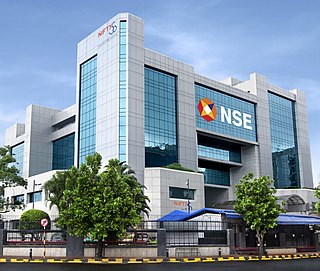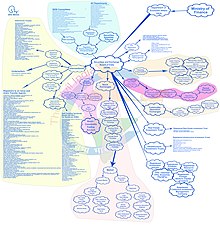
BSE Limited, also known as the Bombay Stock Exchange (BSE), is an Indian stock exchange which is located on Dalal Street, known as the Wall Street of Mumbai, in turn described as the New York of India. Established in 1875 by cotton merchant Premchand Roychand, it is the oldest stock exchange in Asia, and also the tenth oldest in the world. The BSE is the world's 7th largest stock exchange with a market capitalization exceeding US$5 trillion as of May 2024.

National Stock Exchange of India Limited (NSE) is one of the leading stock exchanges in India, based in Mumbai. NSE is under the ownership of various financial institutions such as banks and insurance companies. It is the world's largest derivatives exchange by number of contracts traded and the third largest in cash equities by number of trades for the calendar year 2022. It is the 8th largest stock exchange in the world by total market capitalization, as of May 2024. NSE's flagship index, the NIFTY 50, a 50 stock index is used extensively by investors in India and around the world as a barometer of the Indian capital market. The NIFTY 50 index was launched in 1996 by NSE.
Ketan Parekh is a former stockbroker from Mumbai, who was convicted in 2008 for involvement in the Indian stock market manipulation scam that occurred from late 1998 to 2001. During this period, Parekh artificially rigged prices of certain chosen securities, using large sums of money borrowed from banks including the Madhavpura Mercantile Co-operative Bank, of which he himself was a director.
Securities fraud, also known as stock fraud and investment fraud, is a deceptive practice in the stock or commodities markets that induces investors to make purchase or sale decisions on the basis of false information. The setups are generally made to result in monetary gain for the deceivers, and generally result in unfair monetary losses for the investors. They are generally violating securities laws.

Inter-connected Stock Exchange Ltd. (ISE) is an Indian national-level stock exchange. under the ownership of Ministry of Finance, Government of India. It is responsible for providing trading, clearing, settlement, risk management and surveillance support to its trading members. It started its operation in 1998 in Vashi, Mumbai, and has 841 trading members, who are located in 18 cities. These intermediaries are administratively supported through the regional offices at Delhi, Kolkata, Patna, Ahmedabad, Coimbatore and Nagpur, besides Mumbai.
Bangalore Stock Exchange (BgSE), was a public stock exchange based in Bangalore, India fully owned by Government of India. It was founded in 1963 and had 595 regional and non-regional companies listed. In September 2005, the BgSE announced plans to go public by divesting at least 51% of its ownership. The stock exchange was managed by a Council of Management, consisting of members appointed by the Securities and Exchange Board of India. It was the first stock exchange in South India to start electronic trading of securities in 1996.
Cochin Stock Exchange was an Indian stock exchange in Kochi, Kerala fully owned by Government of India. It was incorporated in 1978. At its peak, it had almost 500 Indian companies listed, and with a daily turnover of ₹70–₹100 crore, it was the fourth largest exchange in India.

The National Spot Exchange Limited (NSEL) is India's first spot exchange under the ownership of 63 Moons Technologies. It was established in view of the then Prime Minister's vision to create a "single market" across the country for both manufactured and agricultural produce.
Qualified institutional placement (QIP) is a capital-raising tool, primarily used in India and other parts of southern Asia, whereby a listed company can issue equity shares, fully and partly convertible debentures, or any securities other than warrants which are convertible to equity shares to a qualified institutional buyer (QIB).
The first introduction of a mutual fund in India occurred in 1963, when the Government of India launched the Unit Trust of India (UTI). Mutual funds are broadly categorised into three segments: equity funds, hybrid funds, and debt funds.
National Institute of Securities Markets (NISM) is an Indian public trust and also the national apex body for the regulation and licensing of financial market dealing profession in India along with being the central civil service staff training institute of SEBI established in 2006 by the Securities and Exchange Board of India (SEBI) the regulator for the securities market in India. It is under the ownership of the Securities and Exchange Board of India, Ministry of Finance, Government of India.
Sandeep Parekh, born 1971, is an Indian financial sector lawyer who founded Finsec Law Advisors, Mumbai. He attended St. Columba's School in New Delhi, India. He then attended Hindu College at Delhi University, which gave him a distinguished alumni award in 2008. 10. He then obtained a degree in law from Delhi University Law Centre II, which also recognised him as a distinguished alumni in 2007. He was profiled in 2006 by CNBC in its program 'Young Turks' by Shereen Bhan as a young leader.
National Spot Exchange Limited (NSEL) case relates to a payment default at the National Spot Exchange Limited that occurred in 2013 involving Financial Technologies India Ltd, when a payment default took place after a commodities market regulator, the Forward Markets Commission (FMC), directed NSEL to stop launching contracts. This led to the closure of the Exchange in July 2013.

The India International Exchange Limited (India INX) is India's first international stock exchange which is launched as a subsidiary of the Bombay Stock Exchange (BSE). It is located at the International Financial Services Centre, GIFT City in Gujarat.

Karvy Group is a financial services company in India. It was involved in financial services like equity, commodities trading, depository and wealth services and distribution of other financial products. It has its headquarters in Hyderabad. It also had branch offices outside India in Bahrain, Dubai, Malaysia, Philippines and the United States. Scams perpetrated during 2019 involving Karvy Stock Broking Limited (KSBL), a group company led to the filing of criminal cases against the Chairman and others. This led to the banning of KSBL by the regulator.
The NSE co-location scam relates to the market manipulation at the National Stock Exchange of India, India's leading stock exchange. Allegedly select players obtained market price information ahead of the rest of the market, enabling them to front run the rest of the market, possibly breaching the NSE's purpose of demutualisation exchange governance and its robust transparency-based mechanism. The alleged connivance of insiders by rigging NSE's algo-trading and use of co-located servers ensured substantial profits to a set of brokers. This widespread market fraud came to light when markets' regulator, the Securities and Exchange Board of India (SEBI), received the first anonymous complaint through a whistle-blower's letter in January 2015. The whistle-blower alleged that trading members were able to capitalise on advance knowledge by colluding with some exchange officials. The overall default amount through NSE's high-frequency trading (HFT) is estimated to be ₹500 billion over five years.
Circular trading is a type of securities fraud that can take place in stock markets, causing price manipulation and often related to pump and dump schemes. Circular trading occurs when identical buy and sell orders are entered at the same time with the same number of shares and the same price. As a result, there is no change in ownership of shares, but there is the appearance of an increased trade volume. Circular trading can be achieved by several parties colluding to achieve the fraudulent outcome. This is not to be confused with wash trading, which is where the same outcome is achieved but occurs through the actions of one investor, rather than a group.
The 1992 Indian stock market scam was a market manipulation carried out by Harshad Shantilal Mehta with other bankers and politicians on the Bombay Stock Exchange. The scam caused significant disruption to the stock market of India, defrauding investors of over ten million USD.
Madhabi Puri Buch is the chairperson of the securities regulatory body Securities and Exchange Board of India (SEBI). She is the first woman chairperson to lead SEBI.
Financial regulation in India is governed by a number of regulatory bodies. Financial regulation is a form of regulation or supervision, which subjects financial institutions to certain requirements, restrictions and guidelines, aiming to maintain the stability and integrity of the financial system. This may be handled by either a government or non-government organization. Financial regulation has also influenced the structure of banking sectors by increasing the variety of financial products available. Financial regulation forms one of three legal categories which constitutes the content of financial law, the other two being market practices and case law.








